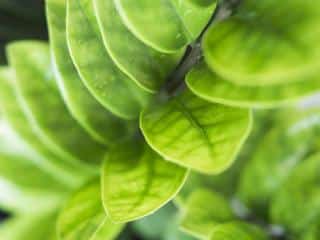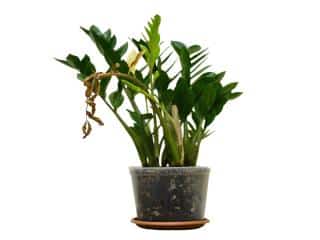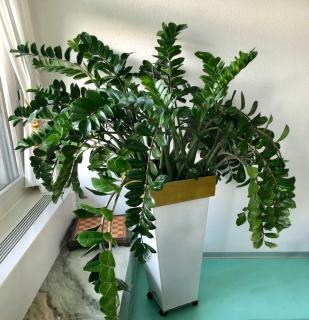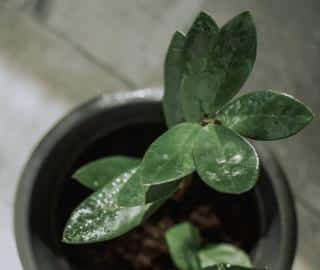

Zamioculcas is such a resilient plant that you won’t have to visit this page very often…
Short summary:
Single stem drying out – normal
Stems falling over – lack of light
Drops on leaf tips – guttation
Yellow – overwatering or chlorosis
Curly leaves – scale or mealybugs, rarely spider mite
So just in case, here are the main problems you might meet when caring for your ZZ plant!
Also, indoor ZZ will generally have less problems than outdoor Zamioculcas (except for overwatering; houseplants are often overwatered).
If the entire ZZ plant is yellow, it may be due to:
 Lacking nutrients – Yellowing is a symptom of chlorosis, typical of nutrient deficiencies. Usually, parts of leaves along veins stay green longer. Add fertilizer for leaf plants once a fortnight during the growing season.
Lacking nutrients – Yellowing is a symptom of chlorosis, typical of nutrient deficiencies. Usually, parts of leaves along veins stay green longer. Add fertilizer for leaf plants once a fortnight during the growing season.The last possibility is when a new frond or leaf starts growing that is yellow, white or variegated. This is rare. It is a kind of mutation that occurs naturally, like the black ZZ raven.
Usually these are considered valuable and you will surely find amateurs! Try to propagate it when it has grown a bit more.
It’s hard to kill a ZZ plant, but if there isn’t much light, it won’t grow very much. Lack of light is the main cause of slow growth. Find a place in the house that is a little more exposed.
If you’re quite sure your plant is getting enough light, then check on watering and temperature swings. These are also known to block ZZ plant from sending out new shoots.

This is a normal step in the ZZ plant’s life. Stems last for up to a year. In very favorable environments, a stem can even survive for 2 years. However, as time passes, the plant sends new shoots out. Older stems are less efficient and they wilt away. The yellowing is a sign that nutrients are being brought back into the roots, a form of recycling.
Only cut the stem when it’s fully dried out if you want to help your plant grow more and faster.
It’s also ok to cut it when not fully dry, the plant won’t complain. After all, it is an ornamental houseplant that has the duty to look good!
More often than not, ZZ plant fronds start drooping down. ZZ stems fall over. The long petioles which carry the leaflets don’t stand upright anymore and fan out.
 The major cause of ZZ plant bending down is lack of light. When a ZZ plant grows in the wild, it grows best in shade and forest underbrush. It sends fronds and leaves in every direction to harvest what little light filters down to the ground.
The major cause of ZZ plant bending down is lack of light. When a ZZ plant grows in the wild, it grows best in shade and forest underbrush. It sends fronds and leaves in every direction to harvest what little light filters down to the ground.What can you do to make your ZZ plant grow straight again?
Another possible cause is that the pot is too small. Repot into a larger pot.
This is normal, it’s the sign of a happy, well-watered specimen. It’s called guttation or weeping leaves.

Also, unneeded nutrients and, eventually, debris from bacteria or dead cells are also evacuated.
If you water with tap water or hard water that has lots of minerals, white spots will appear. Excess minerals are also expelled, and they gather when guttation fluid dries out. In the long term, this can damage the leaves. Indeed, these form corrosive salt mounds. To clean these, simply rinse the plant and wipe it with a soft cloth.

They leave tiny webs as proof of their presence. In the case of mealybugs, a small cottony substance appears.
Here is an article on how to deal with scale insects on a ZZ plant.